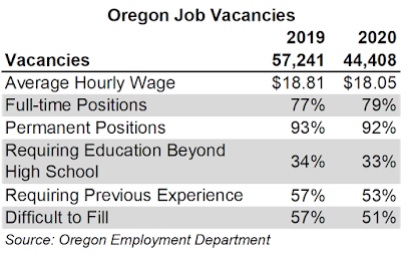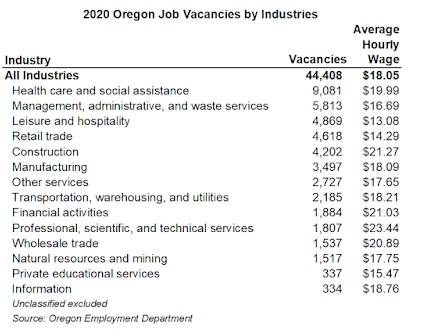Employers reported 44,400 job openings at any given time in 2020. This is a decrease of 22% from the 2019 level of vacancies. 2020 was not a typical year for Oregon businesses, yet many of the characteristics Oregon employers were looking for didn’t change much during the pandemic recession. A typical job vacancy tends to be for a full-time, permanent position. About one-third require education beyond high school and half require previous experience.
Starting in spring 2020, employers were asked “Is this location closed or operations curtailed due to COVID-19 restrictions?” Nearly one out of five (18%) responses indicated a closure or curtailment in spring 2020. The share dropped to 7% in summer 2020 and 6% in fall 2020. The leisure and hospitality and other services industries most often responded that operations were affected. Employers in the Portland-Metro and Northwest Oregon areas reported the highest shares of affected businesses.
In 2020, health care and social assistance reported the most vacancies of any industry (9,000), followed by management, administrative, and waste services (5,800), and leisure and hospitality (4,900). Together these three sectors accounted for 44% of all job openings statewide. Hiring demand was spread across the economy. Except for private educational services and information, all industries reported at least 1,000 job vacancies at any given time in the year.
As education requirements rose, so did the average starting wage for job openings. Job vacancies with no education requirement averaged $14.26 per hour in 2020. That rose to $15.59 for job vacancies requiring a high school diploma. Employers offered an average of $24.75 per hour for jobs with either some college, an associate degree, or a special certification beyond high school. Vacancies with bachelor’s or advanced degree requirements paid even more per hour, averaging $28.24. Shares of job vacancies requiring previous experience also rose along with education requirements.
During the COVID-19 pandemic, employers continued to hire across Oregon’s economy in 2020. Most job vacancies offered full-time work schedules, and employers were mostly looking to fill permanent positions. Vacancies with higher education requirements also came along with a greater likelihood for prior experience requirements, and higher average wages.
Read the full article written by senior economic analyst Anna Johnson here. More information about regional and statewide job vacancies can be found in the Job Vacancy Survey box on the publications page of QualityInfo.org.
Disclaimer: Articles featured on Oregon Report are the creation, responsibility and opinion of the authoring individual or organization which is featured at the top of every article.




